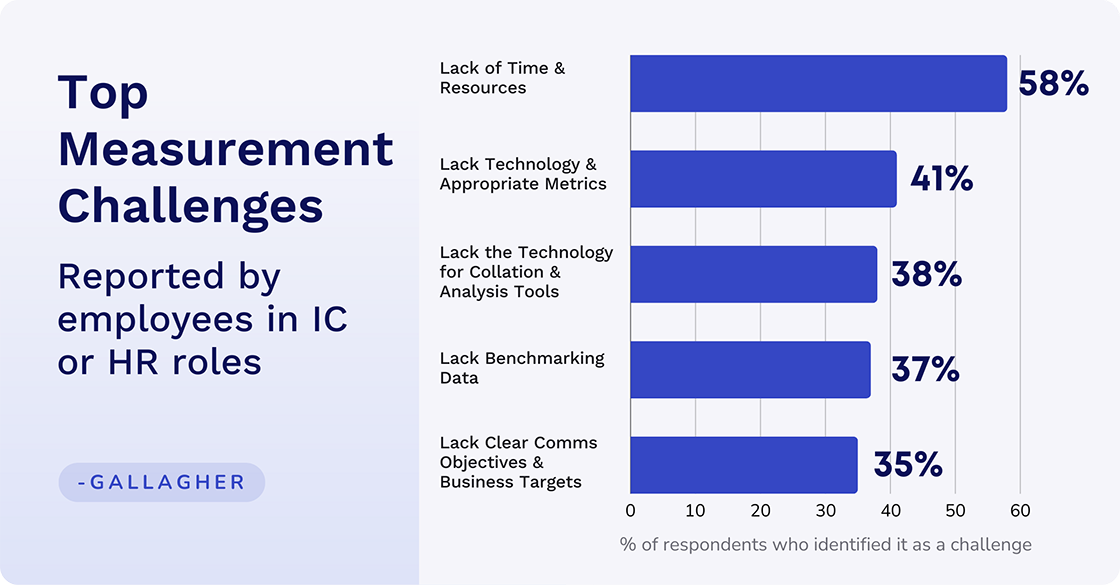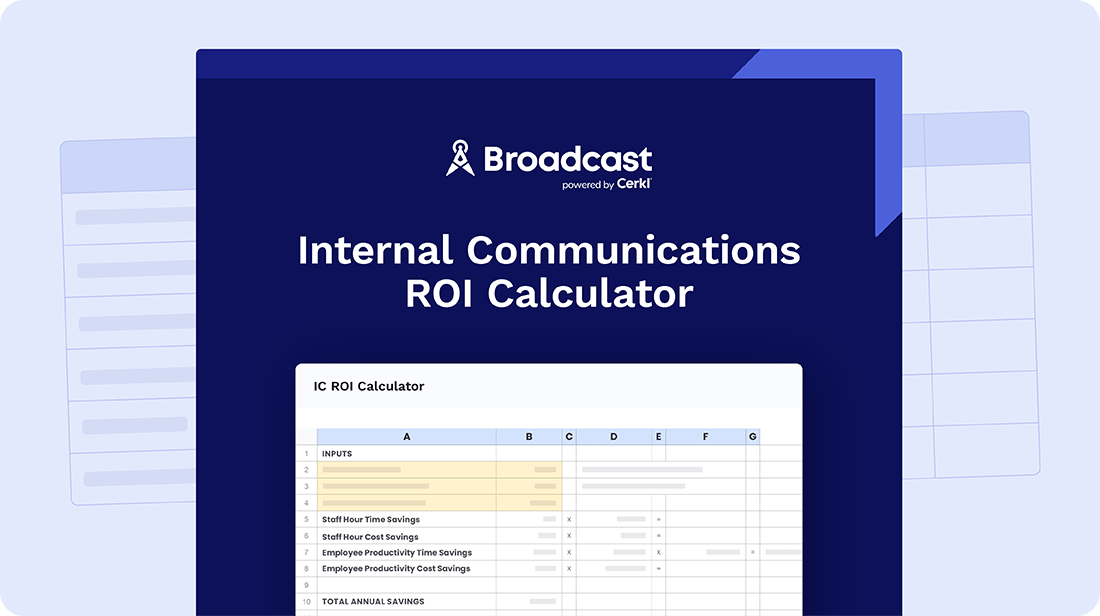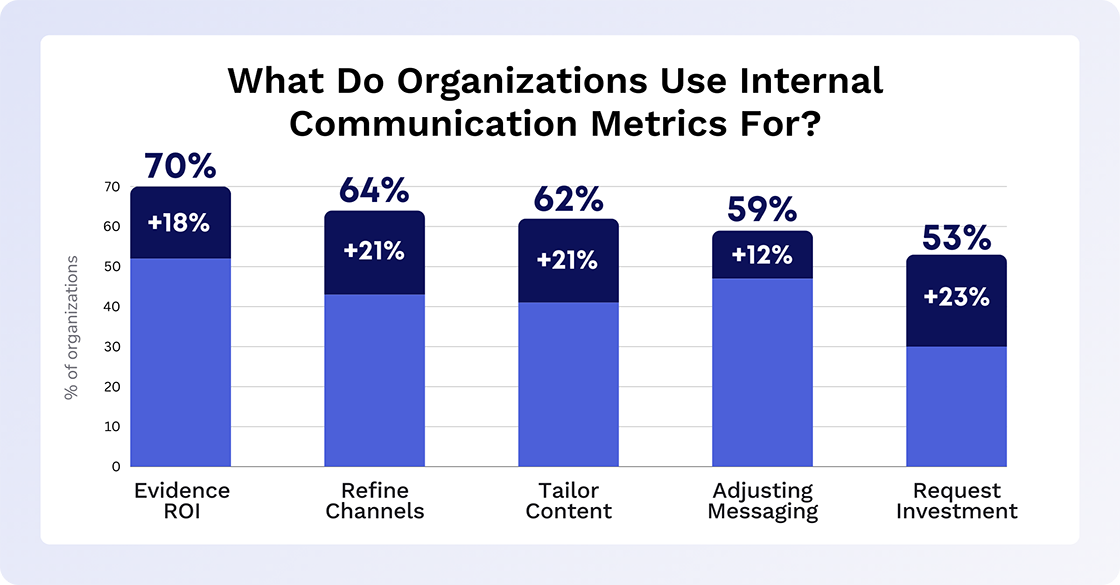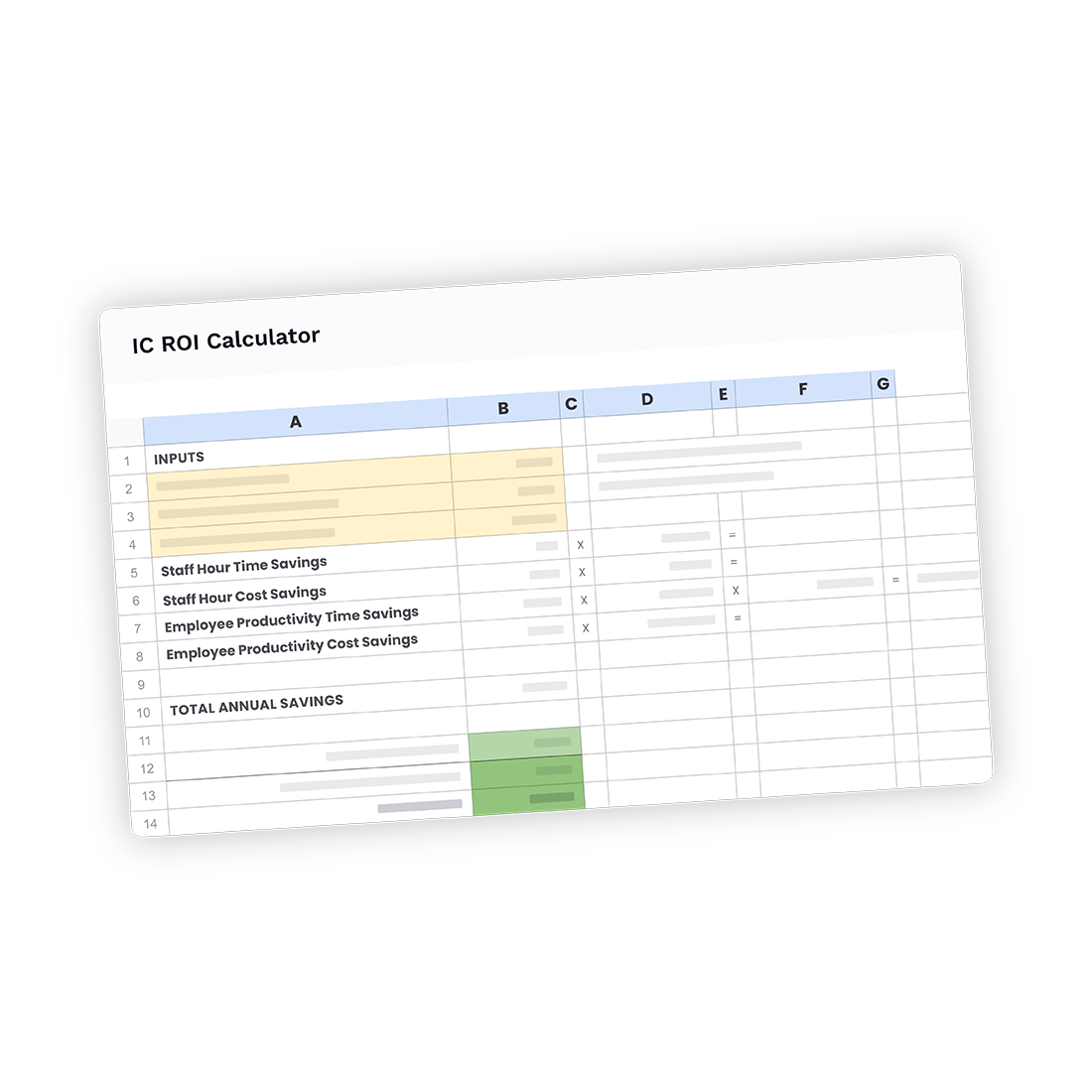 Internal Communications Measurement
Internal Communications Measurement
It’s vital to track and measure internal communication KPIs. We tell you what KPIs are, why they’re important, and how to measure them for optimum ROI.

.png)
Start tracking smarter. Download your free Internal Comms Metric Guide now!
Access NowIn today's competitive business landscape, it is essential to foster a culture of employee engagement. Engaged employees are more productive, satisfied, and likely to stay with an organization. One of the key drivers of employee engagement is strong internal communication, which is why effective internal communication is the backbone of a successful organization. By effectively communicating company goals, updates, and employee recognition, you can create a more connected and motivated workforce.
According to Gallagher’s State of the Sector 2023/24 survey report, increased enthusiasm by organizations to prove return on investment (ROI) is driving demand for measurement. Most of their respondents (72%) were in internal communications or HR roles. Their survey statistics show that 84% want to measure comms impact more often or comprehensively. However, there are several measurement challenges:

Apart from the challenges, how do you know if your internal communication efforts are working? This post details 10 key performance indicators (KPIs) you can track to measure the effectiveness of your internal communications and ensure your messages are getting through loud and clear.
Key Performance Indicators for internal communications help you measure the effectiveness of your efforts in reaching and engaging employees. KPIs do not have to be specific to one employee. You can have department-wide or company-wide KPIs. However you set them up, they are your way of highlighting what’s important to your company’s core vision. Mostly, it’s a number that answers: How do you measure success?
They go beyond simply delivering messages and reveal how well information is understood, acted upon, and how it contributes to your overall communication goals. Internal communication metrics can indicate all kinds of factors from employee engagement to ROI.
Quantify the financial benefits of your internal communications

We can use KPIs to measure every aspect of internal communications from absenteeism and the employee turnover rate to the success of email communications, surveys, and adoption rates for new tools.
Email open and click rates are reputedly the most popular internal communications KPIs, and many organizations find that tracking these metrics is the best way to prove impact. There is also substantial evidence that employee feedback and employee engagement are crucial KPIs. After all, the higher your employee engagement, the more satisfied your workforce is — in this way leading to better productivity and higher retention. However, ironically, there are also strong indications that a large percentage of organizations ignore the value of employee satisfaction surveys to ascertain the effectiveness of internal communications.
So now, let’s focus on how you can use KPIs to encourage employee engagement and get measurable outcomes from your internal communications efforts.
When it comes to internal communications, it’s essential to know whether or not your employees are engaging in the emails that you send to them. Your email communication KPI can include the open rate and/or the click-through rate (CTR). These KPIs are used for measuring internal communication metrics and the effectiveness of your internal communications efforts.
The open rate is the percent of employees that have opened your email. Your click-through rate is the percentage of your employees who have interacted with and clicked on any links in your email. If you want high engagement, you need a high CTR and open rate. If you find that your open rate and CTR seem low, compare them with your national industry rates.
To increase engagement, pay attention to how often you are delivering emails. Your employees are more likely to open company emails when you don’t spam their inbox. Try scheduling company-focused emails around peak open times or allow employees to select their delivery time and frequency.
You can also measure your internal communication reach as a whole. This indicates the extent to which internal messages — including emails — are reaching employees across the organization. It measures the percentage of employees reached through communication channels.
Communication Reach = # of employees reached / total number of employees x 100
If you want to know how your employees feel about where they work, get it from the horse’s mouth. Just be aware that a real measure of engagement doesn’t just come from written answers. It also comes from the response rate.
Response Rate = # of employees asked to take survey vs # of employees who completed the survey
A low response rate highlights a disconnect between your employees and your internal communications team. It doesn’t always mean your employees are purposely ignoring the survey. Maybe they are just slammed with work, or they forget to fill it out. Finding ways to incentivize your employees to participate in surveys creates value and will generate buzz. Once an employee fills out the survey, you might opt to enter them in a raffle for a gift card. This tactic could increase your response rate, getting you the best results out of your survey.

It’s essential to take into consideration that your employees may have survey anxiety. Brainstorm ways you can guarantee your employee’s anonymity, as well as highlighting that if you’re asking, you want to know and will act accordingly.
The employee net promoter score (eNPS) is an internal communications scoring system developed to find out how employees feel about their company. It works by asking direct questions that employees can rate on a scale of 1-10. It covers topics like, “Would you recommend this job to a friend?” Similar to the net promoter score that measures customer loyalty and satisfaction, it calls for answers in three categories:

The eNPS is a quick and easy way to get an overview of employee engagement and employee loyalty. Many organizations are starting to use this method as a way to increase the possibility of organizational growth. The higher your eNPS, the more your employee turnover rate (ETR) will decrease. This, in turn, saves money on hiring and training.
When it comes to taking on new systems in the workplace, it’s beneficial to measure your employee’s adoption of a new process to identify whether it’s adding value to the organization. To estimate adoption rates divide the number of unique users by the total number of users.
Let employees know the benefits of any new tech that your organization may be adopting. Make sure you include ways that new tools will solve their pains. Encourage feedback on what systems work and which ones don’t. It shows them that you care about their opinion and what communication methods and measures they prefer.
If you decide to adopt a new system, offer training sessions for team members so everyone will know how to use the new system, and your team can flesh out any problems. Try to keep your employees engaged in training sessions. Get them excited about the new tech tool by hosting it during lunch or creating a new technology scavenger hunt. Making the process fun and enjoyable for your employees will increase employee engagement and get them excited about adopting a new tech tool!
Unhappy staff will inevitably leave an organization. So, it's essential to see at what point they’re checking out. If you have a large number of people leaving in the first 90 days, it might indicate that the onboarding process hasn’t worked to engage them in the workplace. Conversely, if you find that you’re suddenly losing many of your A team players, this can indicate that there’s an issue with engagement.
When employees leave, you have to replace them with new hires. This can cost as much as 60% of an employee’s annual salary. On top of wages, consider the costs and time used to onboard and train new employees.

You can use the employee turnover rate formula to determine how many of your employees are leaving within a specified period.
Formula: ETR = employees who left x 100 - Average # of employees
According to Understanding Employee Turnover Statistics and Trends for 2024 published by Hubstaff, the average turnover rate is less than 20%. Voluntary departure is about 13%. Of course, industries that rely on students and part-time workers, such as retail and hospitality, will likely have a higher than average ETR.
If you find that your ETR is too high, there are a few things you can do to lower it. Promote flexibility in your workplace, encourage employees to work from home if they wish, create a communication space that allows for regular feedback, and revamp your onboarding process.
If you’re having difficulty getting your staff to show up for work, then your employee engagement levels are suffering. Having a high percentage of employees absent leads to a negative work environment, as one missing team member can affect everybody’s work experience.
The most common way to measure absenteeism is by using the Bradford Factor — a formula for companies to give weight to unplanned absences.
Formula: S2 x D = B
S = separate absences by an individual
D = total number of days absence of that individual
B = Bradford Factor
Using the Bradford Factor enables your organization to get assessment scores for individual employee absence records. You can then use these records to implement a procedure for employees by creating an effective staff absence management strategy. This will help you ensure that employees missing work won’t affect engagement or productivity.
Knowledge retention and understanding assess employees' comprehension and retention of information that is communicated through internal channels Typically, it is measured through knowledge assessment questions.
Knowledge Retention Rate = # of correct responses vs total number of questions x 100
Employee advocacy and participation measure the extent to which employees actively participate in company initiatives, events, or advocacy programs. It indicates their level of engagement and alignment with organizational goals.
Participation Rate = # of participating employees vs total number of employees x 100
This KPI evaluates the effectiveness of different internal communications channels in delivering messages and facilitating employee engagement. It helps organizations identify the most efficient channels for disseminating information.
Channel effectiveness = # of messages received through channel vs total number of messages sent x 100
This internal communication KPI measures the organization's responsiveness to employee feedback provided through internal communication channels. It assesses how effectively feedback is collected, analyzed, and implemented to drive organizational improvements.
Implementation rate = # of implemented feedback suggestions vs total number of feedback suggestions received x 100
Quantify the financial benefits of your internal communications

We’ve discussed what key performance indicators are and we can use these internal communication metrics. But what are organizations using KPIs for in their working environments?
Gallagher’s State of the Sector 2023/24 report reveals that most companies (70%) are using them to demonstrate or provide evidence of ROI. Only 53% use them to ask for investment. A fairly high percentage (64%) use measurement data to refine channels for internal communications. Not quite as many (62%) use them to tailor content for internal communications, and 59% find them useful for adjusting messaging.
The bar chart below is based on data presented in the Gallagher report. It shows what organizations currently use measurement data for. It also provides a year-to-year comparison, which, in all cases, has increased.

Organizations also use these metrics to create goals for employees.
Make sure the goals you set are attainable and will help improve your internal communications strategy and increase employee engagement. The goals you set will ultimately increase your employee engagement rate and loyalty to your organization.
Cerkl Broadcast is designed for internal communications. It serves as a centralized hub for all communication assets, ensuring that communicators can easily access and manage information. It is a versatile platform with many benefits, including analytics tools that will equip you with everything you need to measure the impact of your efforts.
For example, Broadcast will enable you to measure the success of your internal communications in real-time. In addition to measuring open rates, click-through rates and, and content statistics, you can also track your goals. These will depend on your organization’s objectives but might include tracking intranet, newsletter, and specific mobile engagement results.
All your cross-channel metrics will be in one convenient place. You’ll be able to identify what content resonates best with employees. What your employees’ interests are as a workforce and/or on a one-to-one basis.
Discover ROI designed for Internal Communications. Cerkl has a template that you can use to measure the ROI you will get if you opt to use state-of-the-art internal communications.
Get the template for free without any risk or commitment.
Then if you want to know more about how Broadcast can enable you to update and improve your internal communications, the Cerkl team will be here ready to help.

Quantify the financial benefits of your internal communications
What is a KPI for communication? A KPI for internal communications measures the effectiveness of message transmission and reeption. It focuses on how well information is being delivered, understood, and acted upon by the target audience.
What is the scorecard for internal communications? An internal communications scorecard is a dashboard that tracks various KPIs to assess the effectiveness of communication efforts. It can include metrics like employee engagement with communication channels, sentiment analysis of employee feedback, and understanding of company goals.
What are the performance indicators for effective communication? Performance indicators for communication go beyond just delivering messages. They include measures like response rates to surveys or polls, participation in internal events, and reduction in communication-related errors.
What are the 5 main KPIs? While specific internal communications KPIs will vary depending on your goals, some common examples include:
1. Employee awareness of key messages.
2. Employee engagement with communication channels measured by open rates, click-through rates, and so on.
3. Change in employee sentiment that is measured through surveys.
4. Reduction in communication errors caused by misunderstandings.
5. Return on investment (ROI) from communication initiatives that show cost vs. benefits achieved.

Quantify the financial benefits of your internal communications